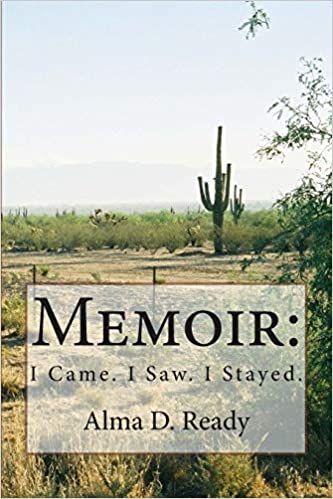Memoir: I Came. I Saw. I Stayed.: (Black and White Version)
About the Author
Author and journalist Alma D. Ready (1907-2003), an only child, was born in Cedarville, New Jersey. At the age of fourteen she was already an accomplished organist. She later went to New Jersey State College in Glassboro where she studied to be a teacher and played a big concert piano for the Glee Club and morning assemblies.
A woman’s life-long search for a home through four unhappy marriages – and the amazing things she did when she found it. As a stranger in a strange land, Alma Ready’s path was a rocky one, but ultimately one that led to her career as a locally well-known Arizona writer, photographer, journalist and historian.
Years later, after three marriages, three divorces and three sons (that she was forced to give up), Alma moved to Tucson, Arizona with her fourth husband and fourth son, Johnny.

She immediately fell in love with the state. “To me,” she said, “the desert was a dream come true.” Totally fascinated with the west, they explored its beauty, venturing farther and farther on weekends and holidays. Alma began carrying a camera and taking notes. She joined the Tucson Camera Club and began winning local photo contests. Her first sale – the first of many – was to Arizona Highways magazine; she also began a series of picture pages for the Arizona Republic’s Sunday Magazine, “Days and Ways.” While trying to put together a portfolio of pictures of Santa Cruz County, she learned from a Nogales librarian that, much to her surprise, the county’s history had never been written. So, “to do the job right,” she wrote, “I needed to live in Santa Cruz County!” By now, she had discovered that she liked to write. In 1967 she leased an apartment in Nogales for a year and joined the local historical society. She also began a new job as Southern Arizona correspondent for the Arizona Republic, the state’s largest newspaper, while at the same time completing her goal of writing the county’s first history to much acclaim: “Open Range and Hidden Silver”. At the age of 60 she had started a new career. By now, she had become very active in Nogales’s Pimeria Alta Historical Society. As society president, she soon realized it needed a great deal of space for a museum. After learning that the old Nogales City Hall was available she ram-rodded a successful effort to move in. Today it occupies the entire bottom floor. For two years she did a monthly full-page photo feature for the Nogales International newspaper. She made many friends, and was a lover of art, music, poetry, and everything Arizona. “I have been very happy here,” she said. “The country is beautiful, the ‘Border Culture’ fascinating, the people friendly and the climate near-perfect. This is where I feel at home.” Alma’s heart indeed found a home in Nogales.